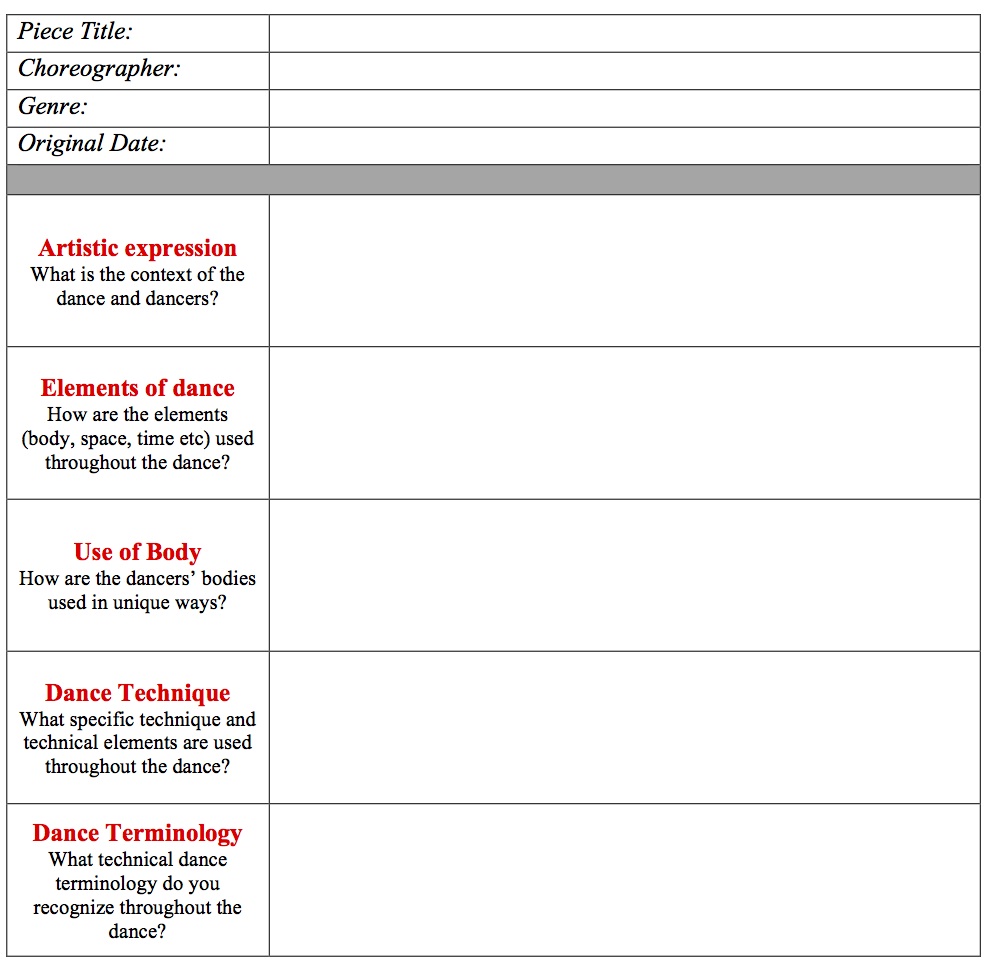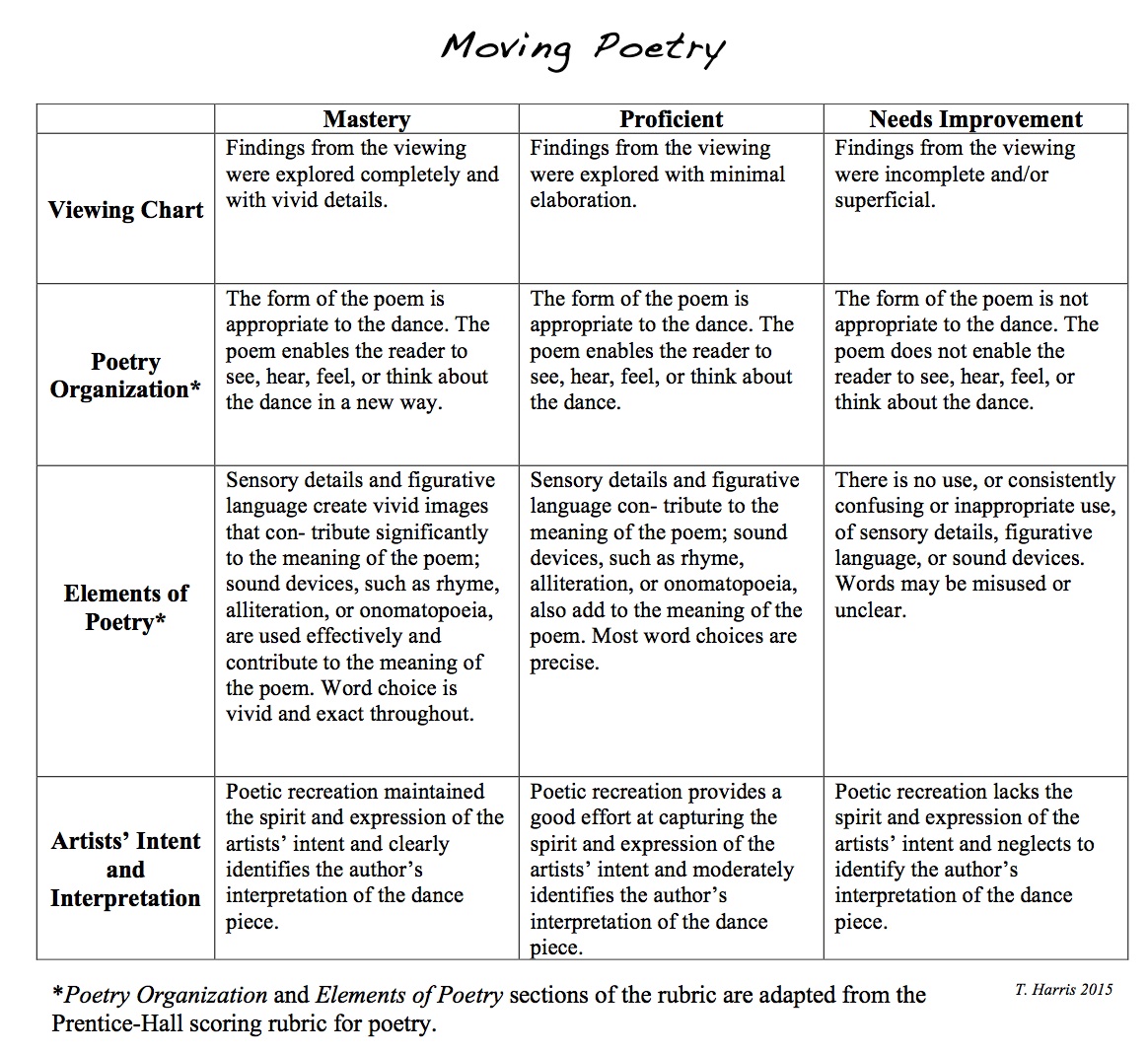Unpacking the National Standards: Anchor Standard 8
6 Min Read • Dance
This month we will be exploring National Standards_8: Interpret intent and meaning in artistic work.
Anchor standard 8 focuses on the artistic process of responding with the component of interpret. The enduring understanding is how dance is interpreted by considering intent, meaning, and artistic expression as communicated through the use of the body, elements of dance, dance technique, dance structure, and context. Although the anchor standard does not change as the grade level progresses the expectation continues to advance.
In unpacking this standard we need to analyze what our students need to know, understand, and be able to do. There are quite a few concepts presented in this standard, so let’s begin with defining the language:*
Artistic Intent:
The artists’ purpose behind the work and intended message to the audience
Artistic Expression:
The manifestations of artistic intent though dance, drama music, poetry, fiction, painting, sculpture or other artistic media. In dance, this involves the dance and the dancers within a context
Dance Structure:
The organization of choreography and movement to fulfill the artistic intent of a dance or dance study (for example, AB, ABA or theme and variation); often referred to as choreographic form
Dance Technique:
The tools and skills needed to produce a particular style of movement
Dance Terminology:
Vocabulary used to describe dance and dance experiences
Simple dance terminology (Tier 1/PreK-2): Basic pedestrian language (for example, locomotor words walk, run, tip-toe, slither, roll, crawl, jump, march, and gallop; and non-locomotor words, bend, twist, turn, open and close)
Basic dance terminology (Tier 2/grades 3-5): Vocabulary used to describe dance movement techniques, structures, works, and experiences that are widely shared in the field of dance (for example, stage terminology, compositional vocabulary, language defining dance structures and devices, anatomical references, dance techniques such as alignment or “line”)
Genre-specific dance terminology (Tier 3/grades 6 up): Words used to describe movement within specific dance forms ballet, contemporary, culturally-specific dance, funk, hip-hop, jazz, modern, tap, and others (for example, in Polynesian dance (Hula), auwana, kahiko, halau, kaholo, uwehe, ami); in ballet: glissade, pas de bouree, pas de chat, arabesque; in jazz: kick ball change, pencil turn, jazz walk, jazz run; in modern: contraction, triplets, spiral, pivot turn; and in tap: shuffle-step, cramp roll, riff, wing, time step
Element of Dance:
The key components of movement; movement of the body using space, time, and energy; often referred to as the elements of movement; see Elements of Dance Organizer by Perpich Center for Arts Education (used with permission)
Genres:
A category of dance characterized by similarities in form, style, purpose, or subject matter (for example, ballet, hip hop, modern, ballroom, cultural practices)
Styles:
Dance that has specific movement characteristics, qualities, or principles that give it distinctive identity (for example, Graham technique is a style of Modern Dance; rhythm tap is a style of Percussive Dance; Macedonian folk dance is a style of International Folk dance; Congolese dance is a style of African Dance)
*For the full glossary of all terms used throughout the national standards go to: http://www.nationalartsstandards.org/
This weeks’ lesson can be modified for all grades K-12 by changing the expectations of response, and can be viewed as a full unit taking multiple days to complete.
Lesson Plan
Grade: 9-12 (but can be simplified for younger students)
Title: Moving Poetry
Established Goals:
a. Select and compare different dances and discuss their intent and artistic expression. Explain how the relationship among the elements of dance, use of body, dance technique, and context enhance meaning and support intent using genre specific dance terminology
Enduring Understanding: Dance is interpreted by considering intent, meaning, and artistic expression as communicated through the use of body, elements of dance, dance technique, dance structure, and context.
Essential Question: How is dance interpreted?
Objectives: Students will
- view various examples of genre specific dance
- select on piece to interpret
- notate the elements of dance, use of body, dance technique, context, and genre specific dance terminology used within the chosen piece
- capture each of the elements in various stanzas of text
- recreate the movement into poetry that clearly identifies the artists’ intent and captures the interpretation of the piece
- demonstrate the understanding of interpretation by completing a gallery walk to identify ance compare interpreted pieces
Learning Activities
1. Have students view and select pieces to interpret. This can be completed in class or at home and can revolve around what you are focusing on in class. For example, if you are working on a modern unit they can research modern pieces. You can place parameters on what pieces can be selected based on your personal vision and goals for the class.
2. Have students view the piece multiple times while completing the Moving Poetry Chart*.
*The chart can be altered to fit your class.
This specific charts in based on the High School Proficient established goals. You can add dance movement principles for High School Accomplished, and genres, styles, and cultural movement practices for High School Advanced. If you are working with younger dancers, you can remove some of the criteria.
Taking it to the next Level!
If you wish to remain at the comprehension level of Bloom’s Taxonomy or Level1/2 of Depth of Knowledge, this can be turned in as a final assignment and will satisfy the national standards. If you have the time and wish to push the students to a high level of critical thinking and analysis, complete the following tasks.
3. Have students translate their findings into 5 poetic stanzas, one for each section of their chart, with one line of each stanza referring to their personal interpretation of the piece. Add an introductory stanza that presents the title and choreographer of the piece as well as the interpretation of the piece and a concluding stanza that presents the genre and original date or performance. Be sure to take the time to review elements of poetry with your dancers which include: sensory details and figurative language, sound devices, such as rhyme, alliteration, or onomatopoeia. This process will also satisfy the following Common Core Anchor Standard for grades 9-10:
CCSS.ELA-Literacy.CCRA.W.4
Produce clear and coherent writing in which the development, organization, and style are appropriate to task, purpose, and audience.
4. Have students publish their poetry in a creative poster and hang the posters throughout the room.
5. Viewing Party. Conduct a viewing party and gallery walk by showing one of the pieces (without revealing the title or choreographer) and then have students walk around to room to read the various poems and choosing which poem best interprets the dance piece. Have student defend their selection by articulating how the stanzas depict the artistic expression, elements of dance, use of body, dance technique, and dance terminology best for the dance piece as a whole. Continue the viewing party for as many pieces as you wish.
Assessment Rubric
Moving Poetry Rubric 
Resources
Elements of Poetry: http://www.poemofquotes.com/articles/elements-of-poetry.php
This is a great activity to complete with professional work, compositional classwork, or student choreography. It offers multiple approaches to viewing all types of dance and, especially with student work, allows student choreographers to see if their intent is clearly explored within their pieces.
Next Week: Coach’s Corner
The Art of Lesson Planning?
As I observe new teachers, I am finding that the art of lesson planning is becoming muddled by time, technology, and temperament. Next week we will explore the art of lesson planning.





